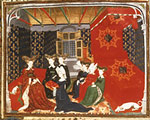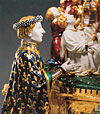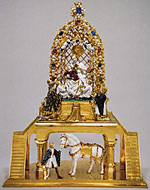sources » Charles VI
Charles VI
Minority
Charles VI of France (1368-1422) succeeded his father, the 'wise king' Charles V, in 1380, just before his twelfth birthday. He was therefore very close in age to Richard II, who was born in 1367, and like Richard he came to the throne as a minor. In his youth he was regarded as promising, handsome and chivalrous. The early years of his reign were marked by magnificent feasts and tournaments as well as by military expeditions in Flanders and elsewhere. He married Isabeau of Bavaria in 1385.
Attacks of insanity

Isabeau of Bavaria among her ladies, From Christine de Pizan, Collected Works, c. 1411-1413 (London, British Library, Harley MS 4431, f. 3)
In 1392 on a hot August day while hunting in a forest near Le Mans, the king had the first attack of the disabling and violent madness which would recur in increasingly frequent episodes for the rest of his life.
Civil war in France
By the early fifteenth century the weakness at the centre of the kingdom led to civil war between rival factions, the Burgundians and the Armagnacs. The murder of the king's younger brother, Louis of Orléans in 1407, was avenged by the murder in 1419 of the Burgundian duke, Jean sans Peur. These events led to the so-called dual monarchy, the years from 1422 to 1435, when the English, supported by Duke Philip the Good of Burgundy, claimed to rule northern France.
The Goldenes Rössl
'The Goldenes Rössl' (this translates approximately as 'White horse of gold'), was given to Charles VI for New Year 1405 by the queen, Isabeau of Bavaria. This is the largest scale and the most accomplished of the surviving objects of this kind, termed 'joyaux' in French inventories. The figures are in the very difficult technique known today as ronde-bosse enamel (enamel in the round). The translucent red enamel, described then as now as rouge cler, could only be applied on gold. On the upper level the Virgin and Child are enthroned, surrounded by a bower. Two angels hold a crown above the Virgin's head. Three infant saints are seated on on the terrace of translucent green enamel. From left to right, they are St Catherine with the ring symbolising her mystical marriage to Christ, St John the Baptist with his lamb, and St John the Evangelist with a chalice.

The Goldenes Rössl. Detail. Charles VI kneels in prayer (Altötting, Church)
On the middle level the king kneels in prayer, accompanied by his marshal, who holds the king's helmet. Behind the king is his tiger, one of his many badges, looking very like a dog. On the lowest level the king's page holds his horse. The idea is that Charles has just dismounted and climbed the steps to pray. The figures are in enamel applied over thin sheets of gold. Some silver is used for details such as the king's armour. The upper two layers are made of gold, but as was usual with such objects, the architectural base is silver-gilt.
It is an open question how far these enamel techniques, in which the Parisian goldsmiths excelled in the years around 1400, had been perfected in the lost objects described in Richard II's treasure roll and made about a decade earlier. White enamel is often mentioned in the roll, sometimes clearly describing objects which had been made in Paris and were in the round. The term rouge clerenamel 'rouge cler' - translucent red enamel over gold also occurs several times, but this technique had been practised at least on a small scale and in two dimensions by the early fourteenth century.
The meeting at Ardres
After very long peace negotiations, Charles VI and Richard II met ceremonially at Ardres, near Calais from 28 to 30 October 1396. This meeting resulted in the sealing of a twenty-eight year truce between England and France and the marriage on 4 November at Calais of Richard and the child, Isabelle. According to convention, Richard addressed Charles, his near contemporary, as his 'father'. Richard is said to have noticed Charles's sorrowful demeanour and to have attempted to console him.
Besides the magnificent presents exchanged each day the kings met at Ardres and the rich trousseau prepared for Isabelle, reciprocal gifts were sent in both directions across the Channel at New Year for the remainder of Richard's reign.
French gifts
Many of the French gifts from Charles himself, his queen and his near relatives, can be recognised in the treasure roll (see St Michael and St Edward and St Edmund). This is one way in which goldsmiths' work from Paris, then reaching a period of extraordinary technical achievement, must have reached London and the English court.

